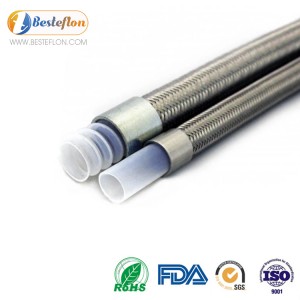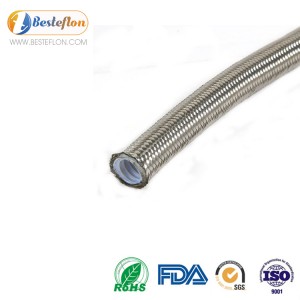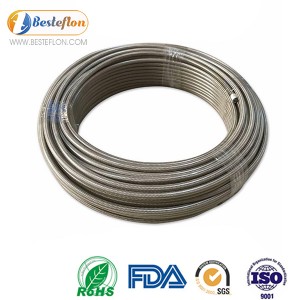In recent years, polytetrafluoroethylene (Teflon) is a kind of anti fouling and anti fouling products for electric power and petrochemical industry. However, the following problems should be paid special attention to when the PTFE lined hose line is welded, otherwise the service life and safety of the PTFE lined pipeline will be affected.
1. When cleaning the assembly fixture, it is strictly forbidden to damage the base metal. It is forbidden to strike arc on the base metal during welding.
2. In the fillet part of fillet weld, the height of fillet weld shall be greater than 5mm, the projection angle shall be greater than or equal to 3mm, and the inner angle shall be greater than or equal to 10mm.
3. When welding the shell of PTFE lined pipe, it is better to adopt the welding method of double-sided butt welding. This requires the technical level of our workers, the weld should be flat (smooth or smooth transition), no pores, welding seam and slag inclusion phenomenon, and the height of the weld should not be greater than 2mm. After welding, the spatter caused by welding shall be completely removed.
4. Continuous welding must be adopted in the welding of PTFE lined pipe, and the weld seam shall not have cracks or continuous undercut. Related Searches: braided PTFE hose, PTFE convoluted hose
Polytetrafluoroethylene (PTFE) is one of the commonly used names of polytetrafluoroethylene. PTFE hose is used in stainless steel hose, so the service life of hose is much longer than rubber hose or rubber hose wrapped in stainless steel. It has many advantages over rubber products.
Class I: PTFE lined straight pipe and pipe fittings
Commonly known as loose liner pipe. In this process, PTFE is used to turn the bar. It is suitable for normal pressure and positive pressure transportation pipeline (such as three waste treatment pipeline, etc.), and should not be used for the pipeline with load (such as the inlet and outlet of pump and the pipeline that can produce negative pressure by drop or sudden cooling).
Diameter specification: dn25-500mm
Service temperature: - 40-180oc
Service pressure: 1.6Mpa
Class II: PTFE tight lined straight pipe and pipe fittings
It is commonly known as tight lining pipe wrapped with steel wire.
Manufacturing process: firstly, several layers of PTFE film are wound on the mold, then the steel wire (Ø 0.5-1mm) is spirally wound on the PTFE film, and then several layers of PTFE thin film are wound on the outside of the steel wire, and finally wrapped in the furnace for forming. The inner wall of PTFE lined pipe made by this process is smooth, and the outer wall is spiral corrugated due to the volume and elastic force of steel wire.
The space between the outer wall of PTFE lined pipe and the inner wall of steel pipe is filled with resin (without residual air). The filling resin can be tightly bonded to the steel pipe. At the same time, it can be tightly wrapped on the outer wall of spiral PTFE liner. After the curing of the filled resin, the spiral ripple is formed which is occluded with the outer wall ripple of the lining. This structure is similar to the combination of nut and bolt. On the one hand, it can effectively limit and compensate the thermal expansion and cold contraction of PTFE lining; on the other hand, the steel wire stiffness can significantly improve the negative pressure resistance of PTFE lining.
Diameter specification: dn25-200 mm
Working temperature: - 50-180oc
Working pressure: 0.5-1.6mpa
The third type: PTFE push (squeeze) pipe tightly lined with straight pipe
Commonly known as push (squeeze) lined straight pipe, it is widely used in developed countries in the 1990s.
Manufacturing process: firstly, the imported PTFE powder is used to push (extrude) the pipe, and then it is forced into the seamless steel pipe (the outer diameter of the liner is slightly larger than the inner diameter of the steel pipe by 1.5-2mm) to form a seamless tight lining. In order to eliminate the pressure, it is put in the furnace and heated to 180oC for constant temperature treatment, so that it can be used in the temperature below 180oC. At the same time, push (squeeze) the shaft of the pipe
The tensile strength is obviously better than that of the wound tube. The pipeline has ideal resistance to positive and negative pressure.
Difference between PTFE lining and rubber lining
Lining tetrafluoroethylene is made use of fluorine's corrosion resistance, high temperature resistance, strong acid and alkali resistance, excellent adhesion, long service life and strong penetration resistance. The whole spraying tetrafluoroethylene is a high-tech work, what are its process flows? 1. Before spraying, the surface needs to be sandblasted and roughened, and a layer of special primer is sprayed. 2. Then the fluoroplastic powder is charged by high-voltage electrostatic equipment, and evenly adsorbed on the surface of the workpiece under the action of electric field. 3. After high temperature baking, the clinker particles will melt into a dense protective layer, which is firmly attached to the surface of the workpiece. For example, a 1 mm thick coating film also needs to be sprayed and baked repeatedly for 5-6 times. Generally, the maximum thickness can be sprayed to 2mm. PTFE lining is a widely used technology at present. It makes full use of fluorine's corrosion resistance, high purity, cleanliness, non stickiness, non wetting, self lubrication, wear resistance, high and low temperature resistance, insulation, etc. in the construction process, its voltage and current are constantly adjusted to the ideal state to achieve the coating effect. Rubber lining is also called rubber lining. It is to stick the processed rubber plate on the metal surface with adhesive to separate the corrosive medium from the metal matrix for the purpose of protection. Natural rubber and synthetic rubber are used for lining. Most of the rubber used in chemical equipment lining is natural rubber. The main component of natural rubber is cis polymer of isoprene, which is vulcanized by adding sulfur. The vulcanized rubber has certain heat resistance and mechanical strength. It can be divided into soft rubber, semi-hard rubber and hard rubber three kinds. Hard rubber has good corrosion resistance, aging resistance and strong bonding strength with metal. Soft rubber has good cold resistance, heat resistance and impact resistance, and has a certain elasticity; semi hard rubber is between two. In addition to strong oxidants and some solvents, hard rubber can resist the corrosion of most inorganic acids, organic acids, alkalis, salts and alcohols. Therefore, the hard rubber lining is used as the main non-metallic anti-corrosion material. Vulcanized rubber can be divided into pre vulcanized rubber, normal pressure hot water vulcanized rubber and natural vulcanized rubber. Pre vulcanized rubber is used in large pickling equipment.
Searches related to ptfe hose:
Post time: Dec-10-2020




